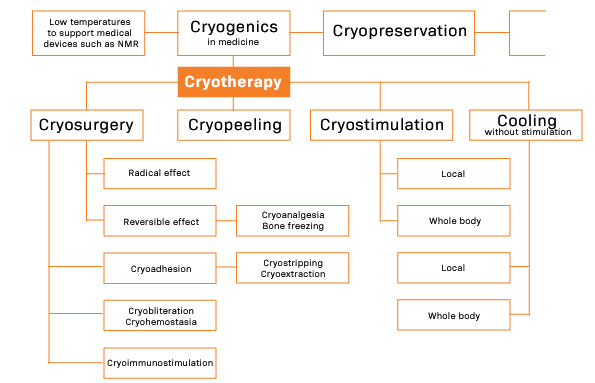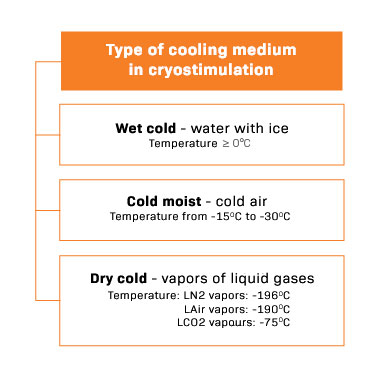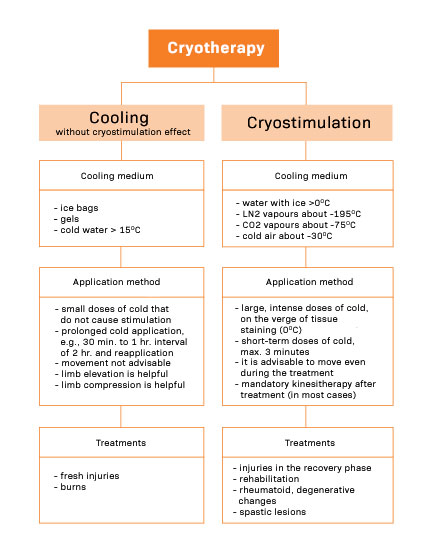Cryotherapy – what needs to be clarified?
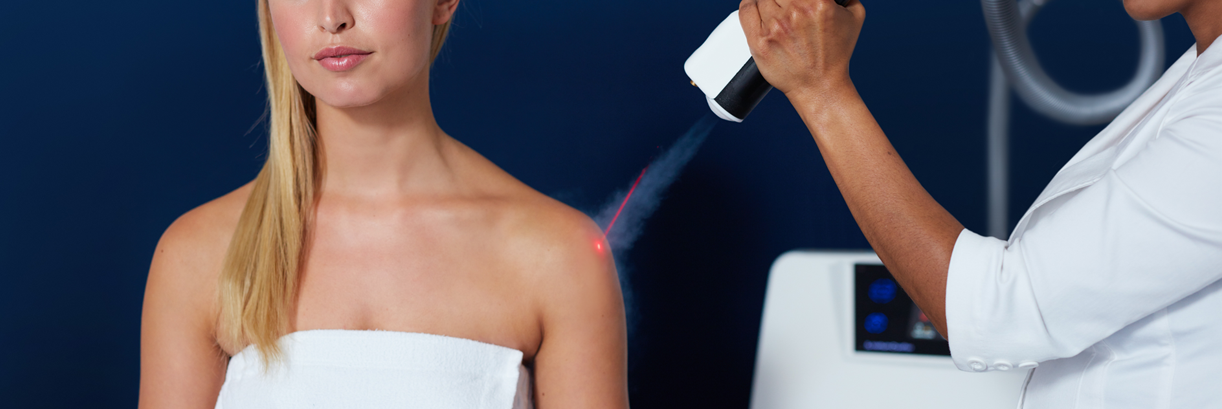
Although cryotherapy is an increasingly common method of treatment, there is still a lack of publications clarifying inconsistencies in nomenclature, giving uniform terms for stimulative and non-stimulative methods. There is also a lack of clarification regarding the refrigerants used and the treatment techniques to achieve the intended cryotherapeutic effects. The following article is an attempt to systematize these inaccuracies so that communication between doctors and patients, and often even doctors themselves, is unambiguous and not misleading.
The term Cryotherapy is overused and too general to describe the correct application.
In order to standardize and clarify certain terms, I suggest tracing Diagram 1.
Placed in the diagram, the term Cryotherapy is very broad in meaning and includes all methods of treatment with cold. Because of its high generalization, the word is very often misused by both doctors and therapists.
When asking about a cryotherapy apparatus or describing the actions performed on the tissue, everyone has something completely different in mind. A gynecologist or dermatologist thinks of destroying tissue by freezing it, while a physical therapist has in mind a stimulating or cooling action that does not damage the tissue. They use the word correct, but not very precise for their purposes.
The division I have proposed, which is partially signaled in some works, into cryosurgery, cryopeeling, cryostimulation and cooling should clarify the matter not only in terms of nomenclature, but also in the subject of methods of applying low temperatures, since each of these four terms requires different application techniques. This is especially true when it comes to distinguishing cryostimulation from cooling, as I can’t find a clear concrete explanation in any work.
The problem of definitions in scientific publications
Let’s go through some definitions of cryostimulation, although the authors use the word cryotherapy interchangeably:
- “Cryotherapy is called the application for therapeutic purposes of a physical stimulus lowering the temperature of tissues” – Prof. K. Spodaryk
- “Cryotherapy is the non-invasive application of extremely low temperatures of cooled air of liquefied gas vapors, locally or systemically radiatively cooling the body’s shells for a period not exceeding a 3-minute exposure.” – Prof. Z. Zagrobelny
- “By this term is meant the stimulus-stimulating application of surface cryogenic temperatures – below -100ºC, acting for a very short time (2-3 minutes), in order to induce and utilize physiological, systemic responses to cold, to support primary treatment and to facilitate motion therapy” – Dr. H. Gregorowicz
- “Cryotherapy is the application to the external surface of the body of temperatures below -100ºC for 2-3 minutes to induce and utilize physiological responses to cold” – Dr. K. Księżopolska-Pietrzak
- “Thus, the idea of cryostimulation is to cool the tissues as quickly as possible and in the shortest possible time in order to induce a reflex congestive response…” – Dr. W. Gawronski
Although the second definition from the point of view of physics contains errors, as will be explained later, I think all authors agree that cryostimulation is about “rapid cooling, almost sucking out relatively very small amounts of heat from tissues” – Prof. Z Zagrobelny. The etymology of the word cryotherapy is described in detail in the work of Dr. W. Gawronski {Rehabilitation 2003, 7, No. 2}. In the emerging works, most authors strictly connect cryostimulation with the so-called extreme temperatures, below -80ºC or, more often, -100ºC knowing that the process must take place quickly, however, temperature is an important, but not the only parameter and the use of a cold source of -100ºC does not guarantee a proper effect. Cold dose is a more objective concept, but it too does not reflect the complexity of the phenomenon of cryotherapeutic treatment.
Types of cryotherapeutic procedures with different indications and courses of action
Cryosurgery:
The fastest way to receive heat is by touching the tissue with a cold metal cryoapplicator or directly spraying liquid cryogen onto it. This is the method used in cryosurgery to destroy tissue. It is not applicable to cryostimulation, since applying the probe or spraying the cryogenic liquid for more than a few seconds would damage the skin, and would not have the intended stimulating effect. This seems obvious, but even here it is possible, by using appropriate techniques, to obtain intermediate effects between cryosurgery and cryostimulation, e.g., if we freeze the cryoprobe in the air so that it is covered with ice (insulator), and then massage the skin with it, without causing prolonged confluence, we will induce strong superficial stimulation: a smaller one is performed for the treatment of alopecia areata or post-erythematous acne, a larger one for cryopeeling.
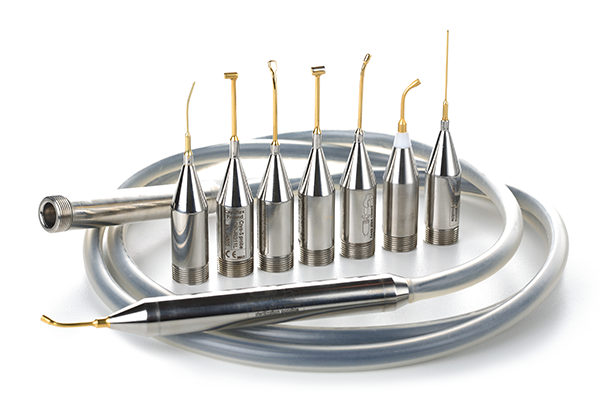
Cryostimulation with ice water:
The fastest, non-destructive method of tissue cooling is ice water. In an ice bath, the heat transfer is dozens of times greater than in a cryogenic chamber, where the air is about -120ºC. The same applies to topical cryostimulation.
This begs the question, why don’t we use ice baths instead of cryochambers? An ice bath is so unpleasant and shocking that it could be used only in a few cases. Heat absorption in the chamber is slower and mainly by radiation in a dry air atmosphere of approx. -120ºC, where the cold is experienced as “friendly”.
Here I would like to introduce the concept of wet cold (ice water), wet cold (air at -15ºC ¸ -35ºC) and dry cold (cryogenic gases below -60 C) – diagram 2.
Each of the above-mentioned factors can be used to induce the effect of cryostimulation. The fastest way is by using ice water, but it is too radical for systemic cryostimulation, and too cumbersome for local application. The patient’s reaction to the type of refrigerant is also different.
Dry cold is least perceived by the patient as unpleasant. Virtually all of us can notice this phenomenon while being outside in winter in different weather conditions.
Moisture in gas below -60ºC is practically imperceptible and such cold is the most comfortable for the patient.
Cryostimulation with liquid nitrogen and carbon dioxide
Local cooling with vapors of liquefied gases, i.e. liquid nitrogen, air (-195ºC) or carbon dioxide (-75ºC). It is a fast, very convenient and patient-friendly way of cooling any part of the body. In local cryostimulation, heat radiation plays many times less of a role than in a cryochamber. It should be added here that the use of CO2 intensifies the radiation heat exchange between the gas and the skin, since the gas absorbs infrared radiation, unlike nitrogen or dry air, which do not interact with thermal (infrared) radiation. The rate of cooling can be controlled by the amount (speed) of the gas jet, using cold air or CO2, or by the distance of the nozzle from the tissue, using LN2. In this way, it is possible to ensure that as much heat is taken away as possible, while not causing damage to the skin (cryodestruction).
From the above considerations, it is clear that the rapid withdrawal of the heat dose does not necessarily involve so-called marginal temperatures, and in the case of topical cryotherapy, it is also impossible to speak of radiation exchange as the main mode of heat exchange. The claim that the effect of cryostimulation can only be induced by using cold below -100ºC is an abuse that has no justification from the point of view of heat exchange. In addition, in physics, the term extreme temperatures refers to temperatures near absolute zero, i.e. about -273ºC (0ºK.)
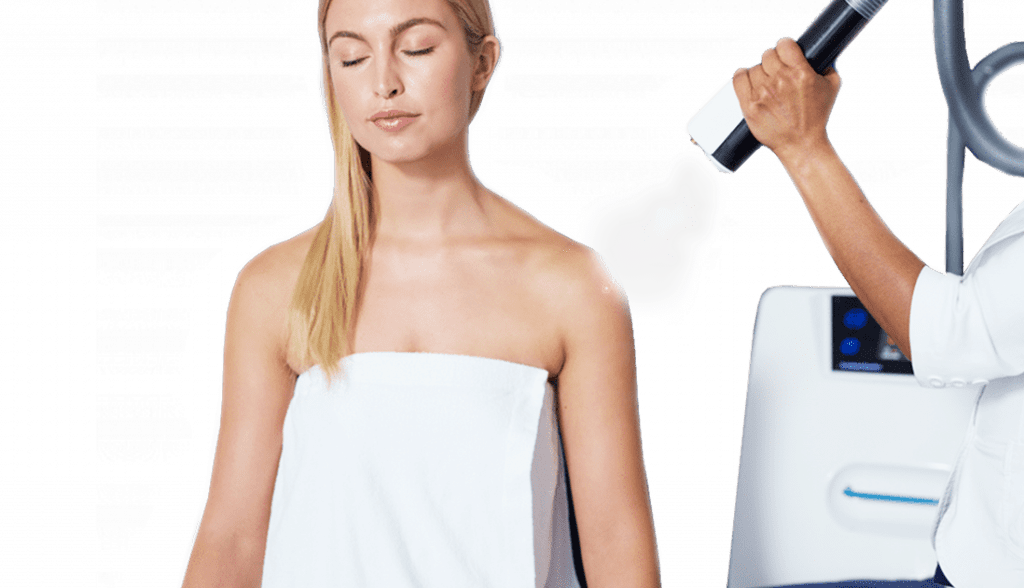
Cooling
Another ambiguity relates to the cooling effect, i.e., taking away heat in such a way that it does not have a stimulating effect. In Diagram 3, you can see that cooling and cryostimulation are completely different modes of action, as to refrigerant choice, application and use.
In the case of cooling, we use ice bags, gels, etc., i.e., agents considered by some authors to be traditional or non-modern. From the point of view of effects, these are inexpensive and the most appropriate means of slowly maintaining tissues at reduced temperatures for long periods of time to prevent further traumatization after fresh injuries. The use of rapid cooling agents, such as ice water, liquid nitrogen vapor or CO2, is inappropriate in this case and can increase extravasation, swelling and further tissue damage. For fresh injuries, probably the most appropriate procedure is recommended in his book by K. Knight, i.e. the PRICE (Procetion, Rest, Ice, Compression, Elevation) procedure.
I would like to point out that ice bags receive heat many times slower than ice water.
According to Prof. K. Spodaryk, the fundamental factors for achieving the intended biological (therapeutic) effect are:
- the rate of cooling, i.e. the time it takes to reach a low temperature in the tissue,
- the temperature reached in the tissue,
- the duration of maintenance of the low temperature in the tissue.
Additional parameters (without going into exact thermodynamic calculations), illustrating the phenomenon of cryotherapy:
| Type of treatment | Intended effect |
Energy dose (cold) |
Energy flux (cold) power cm2 |
Cooling rate | Temperature achieved on the surface of the skin |
Penetration of temperature deep into the tissue |
| Cryosurgery | tissue destruction | small | very large | very large | from -2ºC to -190ºC |
from a few mm to several cm |
| Cryostimulation | increase in blood flow, increase metabolism | medium | medium | large | shallow | |
| Cooling | maintenance reduced tissue temperature | large | small | small | max. about 0ºC | deep |
In cryosurgical and cryotherapeutic practice, it is difficult to objectify the procedure. The proper application of cold lies in the practice and knowledge of the surgeon or therapist. In my opinion, in the available literature, there is a lack of publications by experienced cryotherapists on treatment guidelines and procedures. It is common to see the conducted treatment as “sweeping” from a distance of 30 – 40 cm, a given part of the body. In this case, the use of a cryogenic agent below -100ºC, and a time of more than 3 or more minutes does not guarantee the therapeutic effect.
I suggest paying attention to the various phases of the cryostimulation treatment:
I. Preparation for the treatment:
- Drying the area to be applied by wiping it with spirit or just “swabbing” it with cold cryogen,
- Estimating the treatment time, as the time of 3. minutes is the average time. We anticipate a different treatment time for a heavily muscled or fat person and another for a slim person of low weight.
II. Cold dosage:
- Cold application in a very intensive manner, mainly to the muscle tissue (indirectly through the skin) and less to the skin under which the bone is located (such as the ileal area).
- Achieve a stage of brief skin confluence. This phase of the treatment requires exceptional attention from the therapist and at the same time provides the assurance of rapid, intense heat reception.
- Reaching the stage of “dull pain”, caused (according to one hypothesis) by the constriction of blood vessels, which provides the certainty of a sufficiently deep cooling and induction of the first phase of vascular play.
III. Post-treatment activities:
- Observing whether an active area of congestion has formed with a clear demarcation from the untreated skin surface (second phase of vascular game).
- Observation, (if any) of pale spots on reddened areas. These are painful trigger points, which should be (suggestion) cooled separately with special cryopuncture jets.
Cryotherapy in Poland is becoming more and more popular, mainly due to research and work conducted by academic and clinical centers with the involvement of many people. For my part, through the above comments, I wanted to signal the existing ambiguities from the point of view of thermodynamics and the practice of using cryotherapy, and to present my point of view.
Wiesław Brojek
METRUM CRYOFLEX Sp. z o.o., Sp. k.


